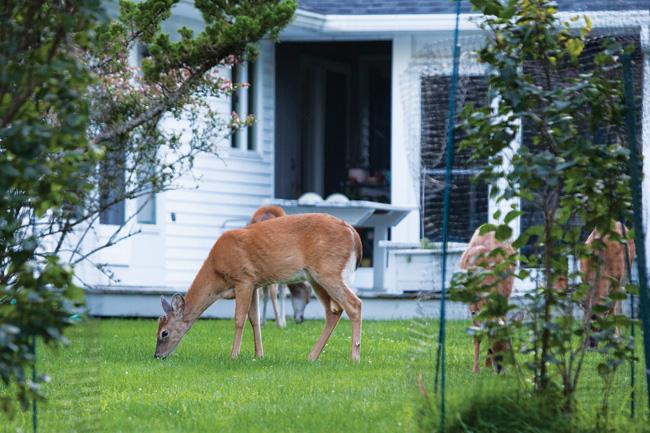Tick committee: Increased hunting needed to cull the deer herd


Since September, the five volunteer members of Southold Town’s tick management committee have been independently researching the growing problem posed by tick-borne illnesses.
In a 24-page report filed with the Town Board Tuesday morning, the group concluded that deer are a main cause of an epidemic of tick-borne illnesses like Lyme disease and without increased hunting efforts, any attempt to quell the stop of tick-borne illnesses would be “destined to fail.”
“We have a health crisis and an environmental crisis,” warned John Rasweiler, the chairman of the tick committee who has also served on Suffolk County’s tick advisory committee. “We have a serious problem that has gone on far too long. We need to use new initiatives. The techniques now being used are not up to the task.”
Mr. Rasweiler — a trained reproductive physiologist who’s also a member of the North Fork Deer Management Alliance and town’s deer management committee — said the North Fork previously had problems with dog ticks, which don’t carry those serious diseases.
The current tick problem, fueled by the spread of lone star and black-legged deer ticks, is a relatively recent development first seen in the 1990s, he said.
“It’s just gone off the charts,” he said.
-

Members of the Southold Town Tick Committee, (L-R) Jim Duggan, Maureen Massa, Laura Klarhe and chair John Rasweiler, present their findings to the Southold Town Board Tuesday morning. (Credit: Paul Squire)
The committee made five recommendations to the Town Board in its report, calling for crossbow legalization on Long Island, expanding hunting on private land, allowing recreational nuisance permits, incentivizing recreational hunting and “humane professional deer harvesting,” which could include hiring professional sharpshooters to cull the herd.
A previous effort to do just that was widely recognized as a failure. In an effort led by the Long Island Farm Bureau, Southold Town contributed $25,000 to match toward a $200,000 federal grant in 2014. Sharpshooters hired by the U.S. Department of Agriculture killed fewer than 200 deer. The divisive effort — which brought together hunters who called for more lax hunting rules and animal activists that called the effort inhumane — was not mentioned at Tuesday morning’s work session.
In discussing other strategies, the committee found that pesticides kill not only ticks, but beneficial and harmless organisms as well. The report noted that pesticides aren’t a “desirable blanket solution to our tick problem.”
In addition, the group found the 4-poster system — a feeding device that uses paint-rollers to coat deer in insecticide as they eat — wasn’t efficient enough for use on a townwide scale.
Mr. Rasweiler said the committee was unable to find any data supporting a link between 4-poster use and a reduction in tick-borne illnesses. He also argued that the devices draw wildlife into a concentrated area, which he believes could devastate the environment.
State environmental protection rules also prevent the systems from being installed too close to residential areas, further limiting their use.
“This is creating new problems that no one is seriously thinking about,” he said. While the 4-poster system is currently used on Shelter Island, he said he’s convinced officials there are “in denial” about its effectiveness.
Mr. Rasweiler used research from Connecticut to back up the committee’s ultimate recommendation: Culling the herd will be necessary to reduce the tick population.
Tick committee member Maureen Massa of Southold said she was hesitant at first to support the destruction of deer, because of their seemingly harmless nature. Then, she said, she was bitten by a tick and contracted three tick-borne illnesses simultaneously.
Now, she said, she backs away when she sees a deer nearby.
“It’s almost like a guy with a knife coming at you,” she said. “I never expected I’d be on disability because of a tick-borne disease. It’s a life-changer.”
Ms. Massa joined her colleagues in calling for more education and early treatment of tick-borne illnesses, saying those solutions would be less controversial among the general public.
Members of the Town Board, including Supervisor Scott Russell, agreed to investigate sending out pamphlets about tick-borne illnesses and questionnaires to help raise residents’ awareness about spotting and treating tick-borne diseases and garner public support for a more permanent solution. The North Fork Deer Management Alliance — not affiliated with the town — presented such a brochure to the board in November.
“When you have human life at peril, that’s more than a problem —it really is a crisis,” said Councilman Bill Ruland, who said the town must pressure local representatives and state regulatory authorities to open up more options for deer management.
“We’re spinning our wheels,” Mr. Ruland added. “The common denominator is the deer … We’re looking for a scientific silver bullet, but it might not be a scientific silver bullet. It might just be a bullet.”
Top photo credit: (Suffolk Times, file)
Southold Town Tick Committee Report April 2016






